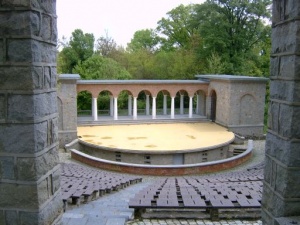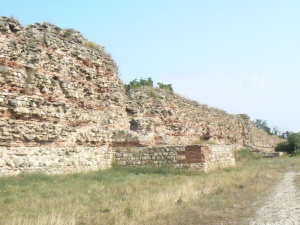Information about Hisarya - Bulgarian spa resort
Hisarya PropertiesThe town of Hissarya has a population of 9308 inhabitants and is situated at 364 metres above sea level. The town is located in a small valley among the south-eastern outskirts of Central Sredna Gora Mountain.
Introduction & History
The modern health resort, with its more than 20 mineral springs and mild climate, has an ancient past. During the Roman rule the town (called Augusta and Sevastopolis) was a wealthy resort centre with Emperor’s palaces, wide stone streets, marble baths, a sewage system and lots of statues of Roman gods. Sick people from all over the Balkan Peninsula, Asia Minor and the Aegean Islands crowded here. The white-as-marble town could be seen from far away, like a dream among luxuriant vegetation, it was famous for its mineral springs throughout the Roman Empire. After being burnt down by the Goths in the 3rd century, it was rebuilt in the beginning of the 4th century, this time with massive and high defensive walls. During the 5th and 6th centuries the town reached its zenith, being part of the Byzantine Empire. After the 6th century it slowly started to decline. Almost all the time between the 9th and the 14th century it’s within the borders of Bulgaria and is known by the name of Toplitsa.
It is located 167 km east of Sofia, 43 km north of Plovdiv, 26 km south-west of Karlovo and 57 km east of Panagyurishte. It is a world famous balneotherapy resort and one of the biggest in Bulgaria.
History & Present
When the Turks invaded Bulgaria, the town put up a rugged resistance, for which it was completely destroyed and the population was massacred. It was in the 17th century when the Turks finally appreciated its natural assets and re-populated the ex-resort, giving it its present name - Hissarya (Fortress) because of the many fortress remains in it. While in Hissarya the population was mainly Turkish, in the nearby villages Verigovo and Momina Banya (now quarters of the town) there lived enthusiastic Bulgarians who took an active part in the fight against the Ottoman rule. In 1868 Vassil Levski founded a revolutionary committee in Verigovo, 15 members of who took part in The Grand People’s Gathering at Oborishte. The village rose in rebellion against the Turkish rule in April 1876 together with other villages in the area, but it was devastated when the April Uprising was suppressed - the village was burnt down, many people were slaughtered, others sent on exile to Cyprus Island, some were driven away.
Today Hissarya is a flourishing town and resort of national importance. The mineral water’s temperature is 24°-49°C and its output is 40 litres per second. It cures diseases of the kidneys, liver, gallbladder, gastritis, diabetes and many more. The most famous spring is the one in the Momina Banya Quarter (Maiden Bath) with its radioactive alkaline water. There is also a mud-cure establishment, which increases the quality of the therapy. There are some mineral drinking-fountains, balneotherapy establishments, a lot of sanatoriums, few dozens of recreational facilities, hundreds of private and departmental villas, a mineral water beach, many parks and gardens.
The Archaeology Museum with a rich archaeological (mainly) and ethnographic exposition (8, Al. Stamboliiski Str., working hours 8.00 a.m. - 12.00 a.m. and 1.30 p.m. - 5.30 p.m. all week round). The Hissarya Fortress has the shape of an irregular tetragon with an area of 300 decares. Its 4th century walls still look impressive and are some of the best-preserved fortress defences in Bulgaria. Their total length is 2315 metres, the walls’ thickness is about 2,5 to 3 metres and their height is 10 metres. The fortress were strengthened with 43 quadrangle turrets. One could enter the town through 4 gates, the main of which was the southern, called Kamilite (The Camels). The northern side has 2 walls, the outer of which is 10 metres away from the inner one, in front of the southern wall there was a 4-metres deep and 10-to-12-metres wide moat. Inside and outside the fortress different kinds of buildings from the ancient town were found - barracks, ancient Roman baths, a late-Roman building (with a colonnade), churches, necropolises. Out of the 5 late-ancient tombs, found in the area, the so-called Hissarya Tomb, also known as the 3rd tomb, is the biggest and most famous. It is a late-Roman (from the 4th century) family tomb, consisting of an overarched passage, a staircase and a burial chamber. The walls of the chamber and the passage are decorated with colour frescoes, and the chamber’s floor is covered with a 4-colour-mosaic. Other interesting sites are the banski buildings (baths) at the springs of Havuza, Momina Banya and Indzheza, the Old-Christian Basilicas from the 5th and 6th century, the Church-Tomb from the 10th-12th century, the Holy Virgin Temple in the Momina Banya Quarter, the St. Dimitur Temple in Verigovo Quarter, the St. Pan-ta-leimon Temple, St. Peter and Paul Church and many more.
Accommodation & Transport
Augusta Hotel (3-star, 3, Gen. Gourko Str.). Krepost Hotel (Fortress) (13, Gen. Gourko Str.). Natalis Hotel (20, Geo Milev Str.). Apriltsi Balneological Complex (66, Ivan Vazov Blvd.). Ministry of Health’s Balneological Complex (12, Gladston Str.). Hissar Balneological Complex (2, Gen. Gurko Str.). These balneology complexes operate as balneo-hotels. There are a lot of private lodgings available through the Accommodation Bureau. As a resort centre Hissarya offers a wide variety of restaurants and places where one can eat and have fun.
Tourist information is available at the hotels, the balneo-hotels, the Accommodation Bureau, and at Orela Tourist Association (16, Augusta Str.).
Hissarya has regular bus lines to Plovdiv, Karlovo, Panagyurishte, Strelcha, the village of Krastevitch and other smaller villages in the area. The town is the last station of the local railway line Dolna Mahala - Hissarya (a deviation of Plovdiv – Karlovo railroad). The bus station and the railway station are located next to each other in the western outskirts of the town.
Surrounding Areas
Hissarya is a starting point of tourist tracks through the Central Sredna Gora Range. From here there are marked tourist routes north-west to the Orela Chalet (The Eagle) (from Verigovo Quarter it takes 5 hours on foot through the short cut or 22 km along a truck road). From the chalet one can proceed to the Chivira Chalet (3 hours), Bogdan Chalet (5 hours), or one can climb Mt. Alexitsa (1 hour), Mt. Fenera (20 min), Mt. Kozya Gramada (20 min). Another tourist route heads south-east to the Voden Kamak Chalet (9 km along a stony road, it is 5 km away from the village of Gorna Mahala). In 2000 during archaeological excavations in the region of the village of Starossel (25 km west of the town) was discovered the grandiose Thracian Temple (5th – 4th century BC) ever found. It is surrounded by a stone wall (up to 5 m high and 240 m long) made of huge stone blocks. The Thracian temple has one front and two side stairs, a long corridor between 5 metres high stone walls. The actual temple consists of a faзade, a rectangular premise and a round premise with an unknown ceiling construction – a unique semi-cylindrical arc and dome. The entrances were closed with massive stone gates. Tens of burial mounds were found nearby, some of them containing tomb-mausoleums of Thracian rules of the 5th and 4th centuries BC. The tombs contain extremely valuable articles – golden jewelry, a set of silver adorning as part of horse ammunition, full armament and other pieces of high scientific, art and museum value. The cult complex is a unique evidence of the Thracian orphic belief in our lands. The complex became attractive for tourists long before its final arrangement and opening.
Hisarya Properties

